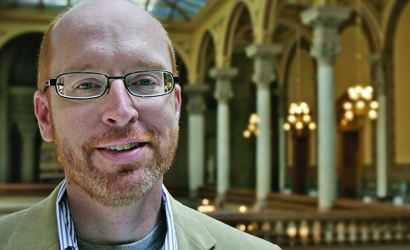Tully discusses power of newspaper perceivers
 Matthew Tully, journalist, had always maintained a curiosity for politics. It wasn’t until later in life he discovered his love of social impact. It was this combination of interests that sparked the idea for a unique endeavor for this Indianapolis Star columnist.
Matthew Tully, journalist, had always maintained a curiosity for politics. It wasn’t until later in life he discovered his love of social impact. It was this combination of interests that sparked the idea for a unique endeavor for this Indianapolis Star columnist.
Tully’s “Manual Project” was a series of 34 columns that appeared in theIndianapolis Star, which chronicled the stories of individuals affiliated with Manual High School, located on the near the south side of Indianapolis.
Tully, who has 20 years of journalistic experience under his belt and previously worked on Capitol Hill, recently visited Ball State University as a Department of Journalism Professionals in Residence Series speaker.
He spoke to students and faculty about his experience at Manual High School. Throughout this year long process, the Indiana University graduate (Hometown native) was able to demonstrate the power of the newspaper, as readers of his weekly column and the community at large came together in support of Manual High School.
The Manual Project “seemed to connect with people and people got engaged in the school in ways that I’d never seen” said Tully. “We as newspapers and newspaper people going forward have to find new ways to connect ourselves with our communities.”
Tully recounted many of the stories he observed in his time at Manual High School during his visit to Ball State. Admittedly there were some tough times. Some students were caught selling drugs, some attacked teachers, and others were victims of abuse at home. However Tully took pride in recalling the positive experiences he witnessed.
According to Tully, the goal-oriented students of Manual all seemed to want to become crime scene investigators, social workers or veterinarians.
“I believe newspapers can play a unique role in our communities and being that force at the center of our community with sparking conversation and connecting people with schools and government and everything else”.
Fred Hopkins, a student at Manual High School, saw the benefits of conversation sparked by one of Tully’s articles. A football player, Hopkins needed specially designed cleats for his size 20 feet. The custom made cleats cost an upwards of $2,500. After Tully’s article was published in the Indianapolis Star, more than $17,000 in donations poured in from the community.
Perhaps one of the most endearing stories came from Tully’s column on Manual’s annual holiday concert. Organized by Manual teacher Spencer Lloyd, the concert attracted thousands of spectators. Previously, the holiday concert had attracted about fifty people to a 1,200 seat auditorium. With the help of Tully’s article, Lloyd’s concert attracted many more members of the community.
Tully reflected that Lloyd’s concert was like a “beam of light” and that he enjoyed nothing more than informing the community about it.
Tully said, “We have to find new ways to tell our stories. We can play an important role in our community.”
Though Manual only has a 39% graduation and is without a student paper or student council, Tully believed their stories needed to be told. In the process of writing his columns on Manual High School, Tully proved that newspapers and the power of the written word still matter.
It is the enduring power of newspapers that have had an ability to bring people together like few other mediums according to Tully. The newspaper experience is one that is shared by an entire community.
“I can’t think of one thing that people do more than read the local newspaper”.



